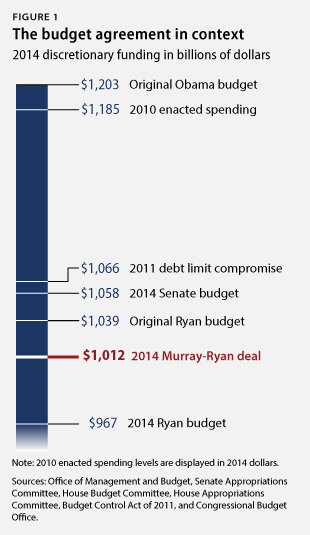Spending Agreement "Splits the Difference" for 2014
On Tuesday, Sen. Patty Murray and Rep. Paul Ryan announced a budget deal that set discretionary spending levels for the next two years, removed some of sequestration's cuts, imposed targeted spending cuts and fee increases, and modestly reduced deficits over the next decade (see our full analysis of the deal).
According to Chairman Ryan, this deal is the first bipartisan budget agreement to come out of a divided Congress since 1986. So where did the final agreement end up?
For the current fiscal year (FY2014), the deal set total discretionary spending at $1,012 billion, exactly halfway between the $967 billion proposed by Ryan and the $1,058 billion in Murray's budget.
One widely circulated graph by the Center for American Progress points out that while the deal represents a compromise relative to the most recent budgets, it actually sets spending levels far lower than envisioned by past budgets – even by those proposed by Chairman Ryan. This is certainly true when looking at discretionary spending as a whole: the original Ryan budget, which was for FY2012, proposed 2014 spending levels at $1,039 billion, well above the $1,012 billion in the current agreement. Budget proposals from the left had set spending even higher.
However, looking at total discretionary spending obscures the fact that the cuts over the past two years have not fallen equally on defense and non-defense spending. Taking our cue from CAP, we've developed a similar chart that shows defense and non-defense spending separately.
As it turns out, the non-defense levels in the Murray-Ryan deal are about halfway between the 2014 spending levels that had been laid out in Ryan's FY2012 budget (his first budget) and the President's. Defense spending, meanwhile, is far lower than either party had envisioned. In other words, relative to FY2012 proposals, the lower spending is driven not by either side being more successful in setting non-defense spending levels, but by a 15 percent reduction in defense spending relative to what either side wanted.
The above chart also offers other insights. Defense spending is a couple billion dollars higher than current spending and more than $22 billion higher than sequester levels, but 6 percent below what Ryan and Murray proposed in their budgets this year. Non-defense spending is also $22 billion higher than the sequester called for, and falls between the proposals of either side.
These numbers only reflect a snapshot of spending in 2014, and show the problem with the current debate. Although both defense and non-defense spending cuts can help to improve the fiscal picture, discretionary spending is already at historically low levels. To truly put the debt on a sustainable path, the real focus must be on tax and entitlement reform. As we noted yesterday, the budget deal did almost nothing to change the trajectory of our debt.
Any fiscally responsible bipartisan agreement is a positive step forward, but policymakers have many more steps to take on the road to a sustainable budget.
*This appendix added after the original posting. For design reasons, we had to choose which budgets to display in the chart and displayed budgets from FY2012 and FY2014. However, we could have reasonably displayed different spending levels and made the same point. Below are some of the defense and non-defense levels in previous budgets.
| 2014 Discretionary Spending Proposed By Various Budgets (billions) | |||
| Policy | Defense | Non-Defense | Total |
| Bipartisan Budget Act of 2013 | $520 | $492 | $1,012 |
| October 2013 continuing resolution | $518 | $468 | $986 |
| Post-sequester (without an agreement) | $498 | $468 | $967 |
| FY2014 Murray budget | $552 | $506 | $1,058 |
| FY2014 Ryan budget | $552 | $414 | $966 |
| FY2012 Obama budget | $610 | $548 | $1,158 |
| FY2012 Ryan budget | $610 | $429 | $1,039 |
| 2011 debt limit compromise | $556 | $510 | $1,066 |
| 2010 enacted spending, increased for inflation | $602 | $583 | $1,185 |
| Original Obama Budget | $600 | $603 | $1,203 |
*Defense and Non-Defense may not add to total because of rounding.
Sources: Office of Management and Budget, House Budget Committee, Budget Control Act of 2011, and Congressional Budget Office.



